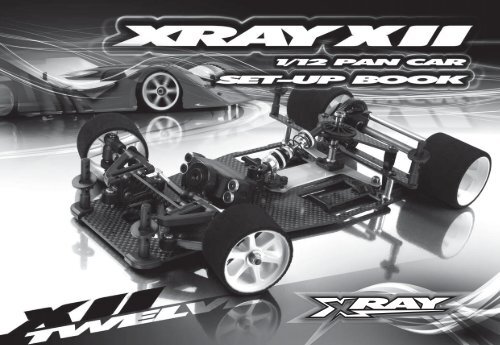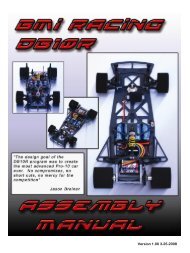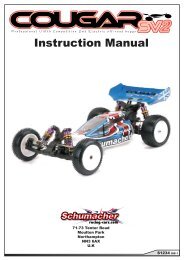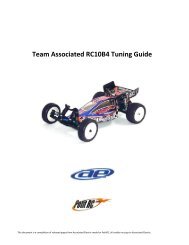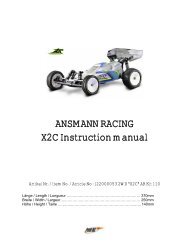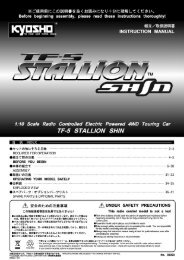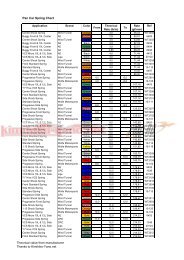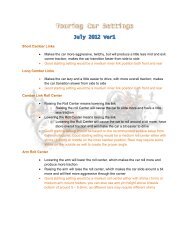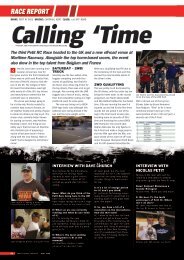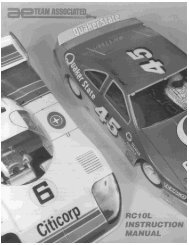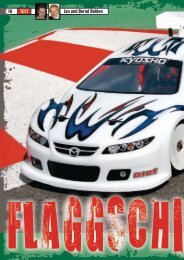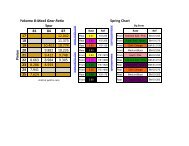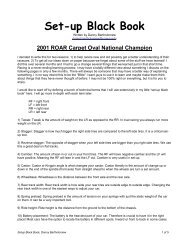You also want an ePaper? Increase the reach of your titles
YUMPU automatically turns print PDFs into web optimized ePapers that Google loves.
CONTENTS<br />
RIDE HEIGHT 3<br />
CAMBER 5<br />
CASTER 5<br />
ACKERMANN 7<br />
TRACK-WIDTH 7<br />
FRONT SPRINGS 8<br />
SHOCK ABSORBER 8<br />
DOWNSTOP 8<br />
POD DAMPING 10<br />
T-BAR 10<br />
BATTERY POSITION 11<br />
FRONT BRACE 12<br />
REAR DIFFERENTIAL 12<br />
SETUP THEORY<br />
This section is a basic overview to setting <strong>up</strong> your <strong>XRAY</strong> <strong>XII</strong> for the first time to ensure that you have a<br />
well-balanced, neutral-handling car.<br />
Car set<strong>up</strong> is a complex matter, as all adjustments interact. Fine-tuning the set<strong>up</strong> will make the car faster<br />
and often easier to drive near its performance limit. This means that all the effort you put into your car<br />
in preparing it and optimizing the set<strong>up</strong> will pay off in better results and more satisfaction.<br />
If you choose to adjust your car set-<strong>up</strong> to better suit different track conditions, make small adjustments,<br />
one at a time, and see if you find any improvement in handling with each adjustment. We advise you<br />
to keep track of your set-<strong>up</strong> changes, and record which set-<strong>up</strong>s work best at different racetracks under<br />
various conditions. You can <strong>up</strong>load all your <strong>XII</strong> set-<strong>up</strong> settings to the <strong>XRAY</strong>‘s On-line Virtual <strong>Set</strong>-<strong>up</strong><br />
Sheet Database at www.teamxray.com and can access your personal settings from anywhere. You can<br />
also benefit from all the set-<strong>up</strong> sheet knowledge and download the set-<strong>up</strong> sheets from <strong>XRAY</strong> factory<br />
team drivers.<br />
Remember that for the car to work and respond to set-<strong>up</strong> changes properly, it must be in good<br />
mechanical shape. Check the well functioning of critical areas such as the free movement of the<br />
suspension, smoothness of shock absorber, and lubrication and wear of transmission parts after each<br />
run, smoothness of differential , T-bar correctness, and especially after a collision.<br />
After rebuilding the chassis, or in case you become lost with your set-<strong>up</strong>, always return to the last set-<strong>up</strong><br />
you have recorded, or use one of the set<strong>up</strong>s posted for your car.<br />
GEARING & ROLLOUT 13<br />
WEIGHT BALANCE 13<br />
TWEAK 14<br />
SERVO MOUNT TWEAK 15<br />
SUSPENSION MOUNTING 15<br />
2
RIDE HEIGHT<br />
FRONT RIDE HEIGHT<br />
Shim<br />
Shim<br />
Shim<br />
Shim<br />
Front ride height<br />
Middle ride height<br />
Rear ride height<br />
Ride height is the height of the chassis in relation to the surface it is sitting on, with the car ready to run.<br />
Ride height needs to be checked in five places:<br />
• FRONT: Front ride height is measured on the left and right edges of the chassis plate.<br />
Front ride height can be adjusted by placing shims at various locations on the kingpin and also under the<br />
front lower bulkhead. Ride height is influenced by the tire diameter. The amount of shims has to be the<br />
same on both left and right sides.<br />
• REAR: Rear ride height is measured at the center of the rear pod plate.<br />
• MIDDLE: Middle ride height is measured in the middle of the chassis plate where the pod and chassis<br />
connect (both left and right sides)<br />
All five of these points should be set as close as possible to achieve a neutral-handling car. A good<br />
starting ride height would be 3–4mm depending on track type and surface.<br />
IMPORTANT:<br />
Measure ride height when the car is race ready (batteries, motor and electronics installed)<br />
DECREASING ride height (lowering the car) increases overall grip and steering response, and is better<br />
on smooth tracks. INCREASING ride height (raising the car) increases chassis roll and is better on bumpy<br />
and asphalt tracks.<br />
FRONT TIRE DIAMETER<br />
Small<br />
Medium<br />
(initial setting)<br />
Large<br />
SHIMS ON KINGPIN<br />
Above <strong>up</strong>per arm = 0.5mm<br />
Above steering block = 1mm<br />
Beneath steering block = 0.5mm<br />
Above <strong>up</strong>per arm = 0.5mm<br />
Above steering block = 1.5mm<br />
Beneath steering block = 0mm<br />
Above <strong>up</strong>per arm = 0.5mm<br />
Above steering block = 0mm<br />
Beneath steering block = 1.5mm<br />
SHIMS UNDER<br />
BULKHEAD<br />
0.5mm<br />
1.5mm (3x 0.5mm)<br />
1.5mm (3x0.5mm)<br />
NOTE:<br />
Recheck ride height every time you change tires or true tires to a different diameter.<br />
3
MIDDLE RIDE HEIGHT<br />
REAR RIDE HEIGHT<br />
Decrease Increase<br />
Adjust middle ride height using spring preload.<br />
Rear ride height htcan be adjusted dby the rear ride height htadjuster bushings.<br />
PRELOAD SETTING<br />
Increase<br />
Decrease<br />
THREADED PRELOAD COLLAR<br />
TIGHTEN collar so it compresses the spring.<br />
LOOSEN collar so it allows the spring to expand.<br />
You must use matching bushings on both left and right sides to ensure the axle is exactly parallel to the<br />
bottom of the pod.<br />
0 2.0 1.5 1.0 0.5<br />
REAR TIRE DIAMETER<br />
Small<br />
Medium<br />
(initial setting)<br />
Large<br />
BUSHINGS<br />
Orient bushings so hole is offset towards the BOTTOM<br />
The smaller the tire, the more the hole is offset towards the bottom<br />
0 offset bushings<br />
(hole in middle of bushing)<br />
Orient bushings so hole is offset towards the TOP<br />
The larger the tire, the more the hole is offset towards the top<br />
4
+<br />
-<br />
CAMBER<br />
CASTER<br />
+<br />
-<br />
Caster describes the forward/backward angle of the front kingpin (and hence the front steering block)<br />
with respect to a line perpendicular to the ground. Caster angle affects on- and off-power steering, as it<br />
tilts the chassis more or less depending on how much caster is set.<br />
A LOWER caster angle (kingpin more <strong>up</strong>right) is better on slippery, inconsistent, and rough surfaces.<br />
A HIGHER caster angle (kingpin more inclined) is better on smooth, high-traction surfaces.<br />
STATIC CASTER<br />
Clips<br />
Camber is the angle of a wheel to the surface on which the car is resting<br />
Front camber can be adjusted by shortening or lengthening the front <strong>up</strong>per turnbuckles.<br />
• INCREASE camber (wheel more angled) by SHORTENING the front <strong>up</strong>per camber link<br />
• DECREASE camber (wheel more <strong>up</strong>right) by LENGTHENING the front <strong>up</strong>per camber link<br />
It is important to have the same camber on both left & right sides. Camber influences the contact<br />
between the tire and driving surface.<br />
We recommend adjusting camber to ensure the front tires wear flat and do not cone.<br />
NOTE:<br />
Check camber frequently. If the front tire is ”coning,” increase or decrease the camber until the tires wear<br />
flat. We recommend setting -1° camber as an initial setting.<br />
2mm 1mm 0.5mm<br />
Static caster is adjusted using clips on the front <strong>up</strong>per pivot pin.<br />
• INCREASE front caster (kingpin more inclined) by moving the front <strong>up</strong>per arm more rearward on the<br />
pivot pin.<br />
• DECREASE front caster (kingpin more <strong>up</strong>right) by moving the front <strong>up</strong>per arm more forward on the<br />
pivot pin.<br />
5
REACTIVE CASTER<br />
FINAL CASTER<br />
REACTIVE CASTER<br />
POSITION<br />
CLIPS IN FRONT<br />
STATIC CASTER<br />
CLIPS IN REAR<br />
FINAL CASTER<br />
1+0.5 2 1˚<br />
1 2+0.5 3˚<br />
0.5 2+1 4.5˚<br />
0 2+1+0.5 7˚<br />
2+1 0.5 2˚<br />
2+0.5 1 3.5˚<br />
2 1+0.5 5.5˚<br />
1+0.5 2 7˚<br />
+ 0.5mm (7.5˚) 0mm (5˚) - 0.5mm (2.5˚)<br />
Reactive caster is used to adjust the amount of caster change when the front end of the car is compressing<br />
(diving) or decompressing (rising).<br />
Reactive caster is adjusted by changing the angle of the front <strong>up</strong>per pivot pin by using the different<br />
inserts (s<strong>up</strong>plied).<br />
• The initial 5° reactive caster angle is a good starting point for car set <strong>up</strong>.<br />
• INCREASING the angle to 7.5° will make the car react quicker and offer more steering.<br />
• DECREASING the angle to 2.5° will make the car easier to drive smoothly into corners.<br />
1 2+0.5 9˚<br />
0.5 2+1 10.5˚<br />
0 2+1+0.5 12.5˚<br />
2+1+0.5 0 5.5˚<br />
2+1 0.5 7.5˚<br />
2+0.5 1 9˚<br />
2 1+0.5 11˚<br />
1+0.5 2 12.5˚<br />
1 2+0.5 14.5˚<br />
6
ACKERMANN<br />
TRACK-WIDTH<br />
Ackermann controls the difference in steering arcs between the front inside and outside wheels. The<br />
inside wheel always has a tighter arc in any corner.<br />
Ackermann can be adjusted by the number of shims that goes between servo saver and ball end.<br />
• MORE shims under the ball end means more Ackermann.<br />
• LESS shims under the ball end means less Ackermann.<br />
Track-width is the distance between the outside edges of the wheels, front or rear, and it affects the car’s<br />
handling and steering response.<br />
FRONT TRACK-WIDTH<br />
MORE ACKERMANN - more steering into the corner, less corner speed, less traction in the chicanes.<br />
LESS ACKERMANN - less steering into the corner, more corner speed, more stabile in the chicanes.<br />
Shim<br />
Shim<br />
7
Wider front track-width decreases front grip, gives slower steering response, and increases understeer.<br />
Narrower front track-width increases front grip, gives faster steering response, and decreases<br />
understeer.<br />
FRONT SPRINGS<br />
Front track width is adjusted by shimming the front wheels on the front wheel axles. It is important to<br />
use same shim thickness on both sides.<br />
• INCREASE front track-width (wider) by using more/thicker shims behind the front wheel.<br />
• DECREASE front track-width (narrower) by using less/thinner shims behind the front wheel.<br />
REAR TRACK-WIDTH<br />
Shim<br />
Shim<br />
Springs<br />
The <strong>XII</strong> comes with medium front springs which are best suited for most racing surfaces. Additional soft,<br />
heavy, and extra heavy springs are available as options.<br />
Your choice of front springs is dependent on the track surface and traction level.<br />
Changing to a SOFTER spring will aid on rough tracks, will help the car get into the corner quicker, and<br />
you will feel that you have more overall steering. As traction increases, to maintain the same car feel you<br />
can increase your front spring rate.<br />
Wider rear track-width increases the stability of the car, increases rear grip at corner entry and middle<br />
corner, and decreases corner speed. Narrower rear track-width increases rear grip at corner exit, increases<br />
corner speed, and increases car responsiveness.<br />
Rear track-width is adjusted by shimming the rear wheel hubs on the ends of the rear axle. Shims are<br />
located between the bearings and diff hubs. It is important to use same shim thickness on both sides. There<br />
must always be a small amount of side play in the axle to ensure it rotates freely and does not bind in the<br />
rear ball-bearings.<br />
• INCREASE rear track-width (wider) by using more/thicker shims between the bearings and the hubs.<br />
• DECREASE rear track-width (narrower) by using less/thinner shims between the bearings and the hubs.<br />
If your car has too much turn-in, go to a STIFFER spring; this will make the car easier to drive and be<br />
smoother in the corners.<br />
FRONT COIL SPRINGS<br />
#372180 C=3.5 GOLD<br />
#372181 C=4.0 SILVER<br />
#372182 C=5.0 BLACK<br />
#372183 C=6.0 GRAY<br />
8
SHOCK ABSORBER<br />
DOWNSTOP<br />
Decrease Increase<br />
Damping, spring tension, and spring preload are all characteristics that determine how the shock performs.<br />
DAMPING<br />
Gap<br />
Decrease<br />
Increase<br />
Rear shock damping partially controls weight transfer of the car front-to-back and also controls the car over<br />
bumps on the track.<br />
• Lighter damping lets the car enter a corner a bit harder and absorb a bumpy track, but the trade-off is<br />
slightly less drive coming out of the corner and a bit of wandering.<br />
• Heavy damping lets the car be smoother entering a corner but it will feel a bit twitchy over bumps. The<br />
car will have more drive coming out of the corner. It is best to use this as fine-tuning when coming to a<br />
new track.<br />
Rear shock damping can be adjusted by the use of different shock oils. It is recommended to use the <strong>XRAY</strong><br />
350 cSt shock oil that is included with the kit.<br />
Other possible shock oils include:<br />
• 200cSt (#359220) • 250cSt (#359225) • 300cSt (#359230) • 400cSt (#359240)<br />
SPRING<br />
The kit provided spring works well in all conditions, however <strong>XRAY</strong> will offer tuning springs to help dial in<br />
your <strong>XII</strong> to any track condition.<br />
Downstop refers to the angle between the rear bottom plate and the chassis plate when the car is loaded,<br />
race ready, sitting on a flat level surface.<br />
This race ready droop is dependant on the amount of shock spring preload. Increasing the center shock<br />
spring preload will stiffen the shock, decreasing the amount the car settles into the suspension. Typically,<br />
with the unloaded droop set at about 1 mm, we set the race ready droop to zero, meaning when placed on<br />
the ground, the car settles into the suspension 1 mm, enough to cause the rear bottom plate and the chassis<br />
to form a straight line.<br />
Downstop can also be adjusted by the length of the shock, this will not change the characteristics of the shock<br />
as the preload will do.<br />
NOTE:<br />
Downstop adjustment to effect the ride height of the car. Be sure to confirm ride height settings after<br />
adjusting droop settings.<br />
• SOFTER rear spring allows more weight to be transferred to the rear of the car, resulting in better rough<br />
track handling over bumps but will reduce the drive of the car coming out of the corners.<br />
• STIFFER rear spring results in better forward drive but sacrifices handling over bumps.<br />
9
POD DAMPING<br />
T-BAR<br />
Diff Grease<br />
(HUDY #106211)<br />
The <strong>XII</strong> comes with a T-bar designed for carpet racing. The T-bar is made from fiberglass and will fatigue<br />
from use, so you should always monitor the edges of the T-bar and replace it when you notice the corners<br />
turning white or if you start to see cracks form. A final indicator for changing your T-bar is if you notice the<br />
car is ill-handling from left to right, and is hard to tweak.<br />
Pod damping controls the side-to-side motion of the car, and is controlled by the thickness of grease you use<br />
between the disks and the pod <strong>up</strong>per plate.<br />
• THINNER grease (lighter damping) will allow the car to dive harder but it will also be more<br />
unpredictable.<br />
• THICKER grease (heavier damping) will allow the car to stay a bit flatter and be easier to drive. If<br />
damping it too heavy the car will wander and feel loose.<br />
T-BAR MOUNTING SYSTEM<br />
2 pivot balls - pro race setting<br />
1 pivot ball - club race setting<br />
The <strong>XII</strong> uses a unique T-bar mounting method that allows for two different settings.<br />
• 2 PIVOT BALLS - PRO RACE SETTING<br />
Both pivot balls are used to mount the T-bar to the chassis for more advanced adjustment possibilities<br />
(recommended for advanced drivers)<br />
• 1 PIVOT BALL - CLUB RACE SETTING<br />
Direct mounting of T-bar to the chassis without the front pivot ball. This gives limited adjustment possibilities<br />
(recommended for beginner drivers)<br />
10
T-BAR TWEAK SCREWS<br />
BATTERY POSITION<br />
Front holes Rear holes Forward position<br />
You can adjust the way the T-bar feels by changing the location of the tweak screws.<br />
• FRONT HOLES: Putting the tweak screws in the pair of FRONT holes will have the effect of lengthening<br />
the T-bar and making it easier to drive and smoother but less responsive to driver input.<br />
• REAR HOLES: Putting the tweak screws in the pair of REAR holes will have the effect of shortening the<br />
T-bar and making it feel more responsive to driver input.<br />
Rear position<br />
Two battery positions are available on the <strong>XII</strong> chassis. The batteries can be moved forward or backwards by<br />
simply changing the location of the battery holders.<br />
• FORWARD battery position increases the stability of the car, gives less overall steering, and more rear<br />
traction.<br />
• REARWARD battery position increases overall steering and corner speed, but makes more rotation offpower.<br />
11
FRONT BRACE<br />
REAR DIFFERENTIAL<br />
Socket Tool 5.5mm<br />
(HUDY #170055)<br />
Alternative 1<br />
Graphite Brace<br />
Try to rotate the spur gear with<br />
right thumb and index finger<br />
Alternative 2<br />
Aluminum Brace<br />
Hold left tire<br />
with left hand<br />
Hold right tire<br />
with right hand<br />
Two options are available for the front brace. A graphite brace is included as stock in the kit. An optional<br />
aluminum brace is available.<br />
• The GRAPHITE BRACE was designed to stiffen the front end, and create a slight push. Producing a car<br />
that is very easy to drive for the average racer.<br />
• The ALUMINUM BRACE provides more front traction compared to the graphite brace, this is<br />
recommended for low traction tracks where you need more overall steering. The aluminum brace is also<br />
aid in preventing chassis tweak in a hard crash.<br />
While holding the rear tires with your hands, use your right thumb and index finger to try to rotate the spur<br />
gear. The spur gear should be very difficult to rotate. If you can rotate it easily, tighten the M3 nut at the<br />
end of the axle. Tighten the nut slightly and recheck the diff again. Repeat this action until the spur gear is<br />
difficult to rotate.<br />
Before you tighten the nut each time, make sure to run in the diff a little bit. You can run in the diff by<br />
switching on the electronics. Use a little throttle and hold one of the rear tires. By this action you are running<br />
in the diff. Alternate between holding one tire, and then the other.<br />
NOTE:<br />
The differential must work smoothly and the spur gear must be difficult to rotate. If the diff is not working<br />
like this, it will have a negative effect on your car’s performance. Make sure to regularly check if the diff is<br />
smooth. If not, you will have to rebuild the diff.<br />
12
GEARING & ROLLOUT<br />
WEIGHT BALANCE<br />
Rollout refers to how far the tires roll for each motor revolution. With foam tires, the diameter decreases with<br />
each run so rollout is continually changing.<br />
Proper gearing is one of the most essential tuning options required to maximize the performance potential<br />
of a touring car. The key to proper gearing is finding and maintaining the best “rollout” for each track<br />
environment, motor/chassis set<strong>up</strong> and driving style.<br />
Rollout is the distance a car will travel in one revolution of the motor shaft. Pinion and spur gears are used<br />
to generate the rollout desired, considering the diameter of the tires mounted. Rollout determines top speed<br />
and acceleration. Usually a higher rollout will provide less acceleration and more top speed, and a lower<br />
rollout will be quicker off the line, but with less top speed. However, electric motors generate their maximum<br />
torque at only 1 RPM and lose torque as the RPM increases. With this in mind, it is possible to lose too much<br />
low-end torque needed to effectively accelerate the weight of the car out of a slow corner by undergearing to<br />
a smaller rollout and having the motor at too high RPM with very little useable torque. On the other side of<br />
the spectrum, if a motor is overgeared at too high of a rollout, the excessive torque will draw amperage from<br />
the batteries too quickly and cause the motor to heat <strong>up</strong> too fast and literally start to burn internally and<br />
destroy itself. A “best case scenario” is that your batteries won’t last an entire race, and a worst case scenario<br />
is that your motor will be completely unusable to race again.<br />
In order to accelerate the process of dialing in the best gearing combination at a track that you have never<br />
raced at, it is recommended that you ask fellow drivers using the same brand and model of motor for their<br />
rollout. Using this information and the calculations explained below, you will be able to match your car’s<br />
rollout to theirs as a good starting point, regardless of the differences between cars.<br />
You should adjust the roll out to maintain acceleration and top speed characteristics.<br />
GEAR RATIO FORMULA: spur gear ÷ pinion gear<br />
ROLL OUT FORMULA: (tire diameter x 3.14) ÷ (spur gear / pinion gear)<br />
This chassis is balanced for brushless motors. When standard brushed motors are used, it is recommended<br />
to use additional shim between motor and the motor bulkhead in order to balance the weight transfer.<br />
DETAIL<br />
Shim<br />
13
TWEAK<br />
Chassis tweak is very important as it sets the weight balance of each front wheel equally. Tweak is adjusted by<br />
the screws in the T-bar. Tweak should be set on a race-ready car with all electronics and batteries installed.<br />
There are a few things to consider before setting the tweak of the car:<br />
• Front suspension should be smooth with no binding<br />
• Front springs have equal shimming and not be over tensioned<br />
• The rear pod should move as freely as possible<br />
• Pivot balls should not be over tightened<br />
• Speed control motor wires should be loose and not bind in any direction<br />
• Brushless motor sensor should be loose and not binding any pod motion<br />
• The car is centered and has equal & symmetrical rear track-width from the center of the pod<br />
• L eft & right tires (as either end of the car) MUST be the same diameter<br />
CHECKING TWEAK<br />
1. Place the car on a flat surface.<br />
2. Press down and release the car several times to settle the suspension.<br />
3. From the front of the car, lift the car in the exact center of the chassis using a thin tool.<br />
4. Observe if the front tires both leave the flat surface at the same time. If they do not, the chassis is<br />
tweaked.<br />
ADJUSTING TWEAK<br />
Chassis tweak is adjusted by tightening or loosening the setscrews that are mounted in the T-bar.<br />
If FRONT LEFT wheel lifts first, the REAR LEFT tire has too much weight on it. Adjust the T-bar setscrews<br />
as follows:<br />
1. Loosen the RIGHT setscrew by 1/8 turn.<br />
2. Tighten the LEFT setscrew by 1/8 turn.<br />
3. Recheck the tweak and repeat steps as necessary.<br />
If FRONT RIGHT wheel lifts first, the REAR RIGHT tire has too much weight on it. Adjust the T-bar setscrews<br />
as follows:<br />
1. Loosen the LEFT setscrew by 1/8 turn.<br />
2. Tighten the RIGHT setscrew by 1/8 turn.<br />
3. Recheck the tweak and repeat steps as necessary.<br />
If needed, adjust tweak until both front tires leave the ground at the same time. Always loosen one screw<br />
first, and then tighten the opposite screw the same amount until tweak is set.<br />
NOTE:<br />
Make sure that both tires (at each end of the car) have the same diameter when checking and adjusting<br />
tweak. Tires with different sizes on left & right sides will cause handling problems (bias the result of tweak<br />
checking).<br />
Properly tweaking the <strong>XII</strong> requires the use of additional tools. We recommend using the HUDY 1:12 <strong>Set</strong>-<strong>up</strong><br />
System.<br />
14
SERVO MOUNT TWEAK<br />
Standard Composite<br />
Servo Mounts<br />
To eliminate the chassis tweak caused by improper servo mounting, <strong>XRAY</strong> offers an optional Tweak-free<br />
Servo Mount Plate which is centrally mounted along the centerline of the chassis while the servo is mounted<br />
independently on aluminum stands on the graphite servo mount plate. This design ensures that the servo is<br />
mounted independently of the chassis and will not produce any unwanted chassis tweak.<br />
The Tweak-Free Servo Mount system is available in two sizes:<br />
#376215 for Mid-Size Servos<br />
#376216 for Micro Servos<br />
Slightly release the<br />
two screws on the<br />
RIGHT mount.<br />
SUSPENSION MOUNTING<br />
It is VERY IMPORTANT to follow the tightening sequence as shown.<br />
It is very important to pay attention while mounting the servo to the composite stands included in the kit.<br />
The servo is positioned offset to the chassis centerline, and as such could easily produce unwanted tweak. To<br />
prevent tweak from the servo, we recommend mounting the servo to the composite mounts, then slightly<br />
release the two screws on the RIGHT mount.<br />
Tweak-Free Servo<br />
Mount Plate<br />
The front suspension is manufactured from composite material which may slightly move or bend when the<br />
mounting screws are tightened. As such it is extremely important to follow these steps to ensure tweak-free<br />
mounting.<br />
1. Mount the assembled left and right suspension to chassis by installing the bottom mounting screws in the<br />
order shown. Tighten the mounting screws VERY GENTLY, and do not overtighten the screws.<br />
2. Fully tighten the screws in exactly the same order as you installed them.<br />
15


